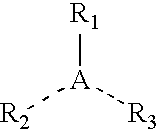Partially or fully neutralized butyl ionomers in golf ball layers
a butyl ionomer and golf ball technology, applied in golf balls, synthetic resin layered products, textiles and paper products, etc., can solve the problems of reducing the resiliency of golf balls, and many solid constructions lacking the “feel” provided by wound constructions
- Summary
- Abstract
- Description
- Claims
- Application Information
AI Technical Summary
Benefits of technology
Problems solved by technology
Method used
Image
Examples
example 1
Preparation of IIR Containing 6.5 mol % of Isoprene
[0096]The following example illustrates the continuous production of a novel grade of IIR possessing an isoprene content of up to 8.0 mol % and Mooney viscosity (ML 1+8@125.degree° C.) between 35 and 40 MU.
[0097]The monomer feed composition was comprised of 4.40 wt. % of isoprene (IP or IC5) and 25.7 wt. % of isobutene (IP or IC4). This mixed feed was introduced into the continuous polymerization reactor at a rate of 5900 kg / hour. In addition, DVB was introduced into the reactor at a rate of 5.4 to 6 kg / hour. Polymerization was initiated via the introduction of an AlCl3 / MeCl solution (0.23 wt. % of AlCl3 in MeCl) at a rate of 204 to 227 kg / hour. The internal temperature of the continuous reaction was maintained between −95 and −100° C. through the use of an evaporative cooling process. Following sufficient residence time within the reactor, the newly formed polymer crumb was separated from the MeCl diluent with the use of an aqueous...
example 2
Preparation of High Isoprene BIIR
[0098]To a solution of 7 kg of Example 1 in 31.8 kg of hexanes and 2.31 kg of water in a 95 L reactor was added with rapid agitation 110 mL of elemental bromine. After 5 minutes, the reaction was terminated via the addition of a caustic solution comprised of 76 g of NaOH in 1 L of water. Following an additional 10 minutes of agitation, a stabilizer solution comprised of 21.0 g of epoxidized soya-bean oil and 0.25 g of Irganox 1076 in 500 mL of hexanes and one comprised of 47.0 g of epoxidized soya-bean oil and 105 g of calcium stearate in 500 mL of hexanes was added to the reaction mixture. After an additional 1 h of agitation, the high IP BIIR was isolated by steam coagulation. The final material was dried to a constant weight with the use of a two roll 10″.times.20″ mill operating at 100° C. The microstructure of the resulting material is presented in Table 1. TABLE-US-00001 TABLE 1 Microstructure of Example 2 Total Unsats (mol %) 5.79 1,4 Isoprene...
example 3
Preparation of IIR Ionomer
[0099]48 g of BB2030 and 4.7 g (3 molar equivalents based on allylic bromide content of Example 1) of triphenylphosphine were added to Brabender internal mixer (Capacity 75 g) operating at 100° C. and a rotor speed of 60 RPM. Mixing was carried out for a total of 60 minutes. Analysis of the final product by 1H NMR confirmed the complete conversion of all the allylic bromide of Example 1 to the corresponding ionomeric species. The resulting material was also found to possess 0.4 mol % of residual 1,4-IP.
PUM
| Property | Measurement | Unit |
|---|---|---|
| Thickness | aaaaa | aaaaa |
| Thickness | aaaaa | aaaaa |
| Diameter | aaaaa | aaaaa |
Abstract
Description
Claims
Application Information
 Login to View More
Login to View More - R&D
- Intellectual Property
- Life Sciences
- Materials
- Tech Scout
- Unparalleled Data Quality
- Higher Quality Content
- 60% Fewer Hallucinations
Browse by: Latest US Patents, China's latest patents, Technical Efficacy Thesaurus, Application Domain, Technology Topic, Popular Technical Reports.
© 2025 PatSnap. All rights reserved.Legal|Privacy policy|Modern Slavery Act Transparency Statement|Sitemap|About US| Contact US: help@patsnap.com

